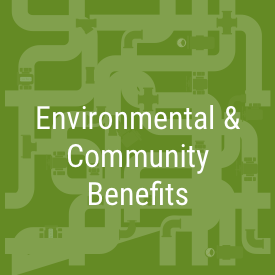This project is a partnership with the California State Coastal Conservancy, the U.S. Army Corps of Engineers (USACE) and regional stakeholders to provide tidal flood protection, restore and enhance tidal marsh and related habitats, and provide recreational and public access opportunities along Santa Clara County’s shoreline.
This project relies on federal participation from the USACE to develop the project and prepare the plans. Without federal participation, Valley Water cannot implement planning, design and construction on our own due to limited available funding. The Safe, Clean Water funding provides a portion of the local share of funding for planning, design and construction phases for Economic Impact Areas (EIAs) 1-4, and a portion of the local share of funding for the planning study and design phases for EIAs 5-9.
The 2012 Safe, Clean Water Program has already provided $15 million as a portion of Valley Water’s local share of funding for flood protection improvements in Economic Impact Area (EIA) 11, which is the urban area of North San José and the community of Alviso. Once completed, EIA 11 will provide flood protection to more than 1,000 residential structures and 100 non-residential structures, and allow for the restoration of 2,900 acres of tidal marsh and related habitats.
The project will provide coastal flood protection from a rising sea level, and will restore and enhance tidal marsh by using a combination of flood protection levees, wetlands and transitional zone habitats also known as ecotones. Ecotones will provide an additional protective buffer for the levee and allow marsh habitat to migrate upslope as the sea level rises. This approach of using natural infrastructure will help develop a resilient and adaptable flood protection system that can evolve in the future.
(Photograph by Cris Benton)








This is a U.S. Army Corps of Engineers (USACE) led project, in partnership with Valley Water, and the California State Coastal Conservancy (Conservancy). Due to the extent of the project area, the project was split into 11 Economic Impact Areas (EIAs). Phase I of the project includes EIA 11 in the Alviso area of the City of San Jose. Phase II focuses on EIAs 1-4, from San Francisquito Creek in Palo Alto to Permanente Creek in Mountain View. Phase III is also known as the Shoreline (Sunnyvale) Feasibility Study and focuses on the remaining EIAs 5-10, from Permanente Creek in Mountain View to Guadalupe River in San José.
Shoreline Phase II Study Conclusion
The Shoreline Phase II Study has concluded after finding no federal interest in a future project at this time. Please see the fact sheet here for more information.
Public Scoping Meeting for the South San Francisco Bay Shoreline Phase III / Sunnyvale Study
Held on February 13, 2024 at Fair Oaks Park Building in Sunnyvale, CA, the U.S. Army Corp of Engineers and Valley Water received community input during a meeting about the coastal flood risk along the South San Francisco Bay.
Economic Impact Area 11 (Phase I)
Economic Impact Area (EIA) 11 includes the urban area of North San José, the community of Alviso and the San José-Santa Clara Regional Wastewater Facility. The 2012 Safe, Clean Water Program provided $15 million as a portion of Valley Water’s local share of funding for flood protection improvements in EIA 11. There are five reaches under EIA 11 (Phase I). See map here.
Construction work on Reaches 1 through 3 began in December 2021 and is estimated to continue until Summer 2025. Reach 1 extends from Alviso Marina to Union Pacific Railroad and Reaches 2 and 3 stretch from the Union Pacific Railroad to Artesian Slough. Daily construction hours are 7 a.m. to 5:30 p.m., Monday through Friday, and on weekends if necessary, excluding holidays. Work to date has consisted primarily of removing water from the work area, removing the existing berm, and replacing it with a more suitable material foundation for the levee. Work crews have set up coffer dams and sheet pile wall systems to isolate the construction area from the surrounding pond areas. To date, crews have built the Reach 1 levee alignment to elevation 15.2 feet and are currently installing rodent control measures along the slopes. Approximately 65% of the Reaches 2-3 levee alignment is built to elevation 15.2 feet There will be no public access to trail users across the Pond A12, A13, A16, and A17 berms that are within the construction work area. See the fact sheet here.
Design of Reaches 4 and 5, which extend from the Artesian Slough East to Coyote Creek, are on hold while construction phasing, access points, haul routes, staging, and easements are being addressed with the property owner. USACE and the non-federal partners are looking for alternative measures that meet project objectives and reduce construction costs. Before being put on hold, 60% levee design plans and specifications were completed in October 2020.
A multi-agency partnership
The Shoreline Project is a strongly supported project as evidenced by the signing of the USACE Chief's Report in December 2015, with a total Feasibility Study cost of $22 million, followed by its authorization for design and construction in the Water Infrastructure Improvements for the Nation Act in December 2016.
The total project cost is $545 million to implement coastal flood risk management, ecosystem restoration, and recreational project elements. The project has received $124 million under the USACE 2018 Disaster Supplemental Appropriations Bill. California State Coastal Conservancy’s (Conservancy) and Valley Water’s total local cost share of the project is $400 million. Valley Water’s local cost share is $298 million, and the Conservancy’s local cost share is $102 million. Valley Water has secured $15 million from the 2012 Safe, Clean Water program and $61 million from the San Francisco Bay Restoration Authority’s Measure AA program. The remaining share of Valley Water funds will be from the Watershed Stream Stewardship Fund and Senate Bill 881 will allow Valley Water to be eligible for reimbursement from the Department of Water Resources (DWR) State Subventions Program pending DWR funding availability. Future federal appropriations of $17 million will be required for restoration monitoring.
For significant EIA 11 project milestones reached, click here.
Economic Impact Areas 1-4 (Phase II)
Economic Impact Area (EIAs) 1-4 include the shoreline areas located between San Francisquito Creek in Palo Alto and Permanente Creek in Mountain View. It includes the communities of Palo Alto and Mountain View. The Phase II Feasibility Study was concluded in April 2024.
Current activities:
- The USACE Study determined that the damages from coastal flooding are not great enough to justify the cost of a levee until sea level rise is greater in several decades.
- USACE has finalized study documentation and is concluding the study.
- Valley Water is considering alternate means of working with local partners or USACE on smaller projects in the study area to address near-term coastal flooding.
Economic Impact Areas 5-10 (Phase III / Sunnyvale Study)
Economic Impact Area (EIAs) 5-10 include the shoreline areas located between Permanente Creek in Mountain View and the Guadalupe River in San Jose. It includes the communities of Mountain View, NASA, Sunnyvale, San José, and Santa Clara. The Shoreline (Sunnyvale)/Phase III Feasibility Study was initiated in August 2023.
Current activities:
- The USACE is developing a hydraulic model for the study area, gathering data from local stakeholders, and developing project alternatives. The USACE’s first milestone in its planning process, the Alternatives Milestone Meeting is being held over two meetings. The first meeting was held in May 2024, and the second will be held in late 2024. The purpose of the milestone is for the USACE team to gain alignment on the proposed feasibility study scope, schedule and budget. Schedule and budget for this project will be updated following the second meeting.
- EIA 10: Valley Water is working with the South Bay Salt Pond Restoration Project team to plan flood risk management efforts in EIA 10 (Calabazas/San Tomas Aquino Creek-Marsh Connection Project).
EIAs 5-10 Completed milestones:
- Valley Water completed a Preliminary Feasibility Study in March 2017 for EIAs 1-10.
- Valley Water completed a Visioning effort in 2019 in partnership with the San Francisco Estuary Institute, Google, the City of Sunnyvale, Lockheed Martin, the Midpeninsula Regional Open Space District, NASA, the US Fish and Wildlife Service, and the South Bay Salt Pond Restoration Project. The Vision group successfully lobbied Congress for dedication of funds, increased alignment between stakeholders, explored synergies between individual planning efforts, and gathered data USACE will need for their analysis. An executive summary documenting the Vision group’s efforts was finalized in December 2021 and can be accessed here.
- The Study received federal funding, the Feasibility Cost Share Agreement between Valley Water and USACE was signed, and a kickoff meeting was held in August 2023. The Conservancy signed on as a local sponsor via an amendment in October 2023.
- A planning charrette was held in late November 2023 to identify potential project alternatives.
- Additionally, a public scoping meeting was held in February 2024. (See link to meeting materials above) to gather public feedback on the study.
August 2024
Public Notification
Project Fact Sheets
Economic Impact Area 11
-
EIA 11 Milestones - updated April 2022
-
The USACE Chief's Report is available to download from here.
-
The conformed Board agenda memo for the certification of the Environmental Impact Report (EIR) is available to download from here.
-
The Final Integrated Document consisting of the study’s Feasibility Report and combined EIR/EIS can downloaded from the following links:
Final Interim Feasibility Study with Environmental Impact Statement / Environmental Impact Report
Appendix A: NEPA/CEQA Supporting Documents
Appendix B: Supporting Planning and Environmental
Documentation and Information (Appendix B1-B6 and Appendix B7-B12)
Appendix D: Hydrology and Hydraulics
Appendix E1: Civil Design and Cost Engineering
Appendix E2: Basis of Cost Estimate Memorandum
Appendix F: Monitoring and Adaptive Management Plan for Ecosystem Restoration
Appendix G: Geotechnical Engineering
Errata to Final EIR + CEQA Summary 020916
Addenda to FEIR/FEIS:
- Addendum No. 1
- Addendum No. 2
- Addendum No. 3
- Addendum No. 4
- Addendum No. 5
- Addendum No. 6
- Addendum No. 7
- Supplemental Information Report to the FEIS: https://www.spn.usace.army.mil/Missions/Environmental/
- South San Francisco Bay Shoreline Supplemental Information Report June 2023
- South San Francisco Bay Shoreline Supplemental Information Report Feb 2023
- South San Francisco Bay Shoreline Supplemental Information Report July 2021
- South San Francisco Bay Shoreline Supplemental Information Report May 2021
- South San Francisco Bay Shoreline Project Final Supplemental Information Report Nov. 2020
Economic Impact Areas 1-10
-
The Preliminary Feasibility Study for EIAs 1-10 can be downloaded from the following links:
Appendix 1: Long Wave Modeling Report
Appendix 2: Statistic Analysis of Water Surface Elevation
Previous Public Meeting Materials
- February 13, 2024: Public Scoping Meeting for the South San Francisco Bay Shoreline Study at Fair Oaks Park Building in Sunnyvale, CA.
- The U.S. Army Corp of Engineers and Valley Water received community input during a meeting about the coastal flood risk along the South San Francisco Bay.
FY22-36 Key Performance Indicator for the Safe, Clean Water Program
-
Provide a portion of the local share of funding for planning, design and construction phases for the Santa Clara County shoreline area, EIAs 1-4.
-
Provide a portion of the local share of funding for planning and design phases for the Santa Clara County shoreline area, EIAs 5-9.
Benefits
-
Provides planning and design to protect nearly 4,700 acres and more than 5,000 structures, including roads, highways, parks, airports and sewage treatment plants in Santa Clara County
-
Allows for restoration of tidal marsh habitat for endangered wildlife such as the salt marsh harvest mouse and Ridgway’s rail; rich feeding grounds for shorebirds; and nursery areas for young fish such as leopard sharks and steelhead
-
Provides educational, recreational and public access opportunities
-
Protects more than 4,300 structures (EIAs 1-4)
-
Allows for the restoration of 400 acres of tidal marsh and related habitats (EIAs 1-4)
-
Addresses climate change
Geographic Area of Benefit
Milpitas, Mountain View, Palo Alto, San José, Santa Clara and Sunnyvale
Flooding History and Project Background
This project stems from the 2003 acquisition of thousands of acres of former South Bay salt production ponds, purchased for restoration with combined public and private funding. The South Bay Shoreline Protection Project is an important component of the South Bay Salt Ponds Restoration Project, a large, multi-agency effort to restore 16,500 acres of tidal wetlands which involves all South Bay cities that meet the San Francisco Bay. Without incorporating flood protection measures, proposed recreational use and environmental restoration is likely to reduce the effectiveness of existing shoreline levees formerly maintained for salt production. Project E7 would upgrade levees to protect Silicon Valley’s “Golden Triangle,” bounded by Highways 101, 237 and 880, and extending north into the Baylands of Milpitas. Multiple flood events since the mid-1990s have damaged business operations in this area, now home to major high-tech corporations including Intel, Google, Yahoo, Cisco, and others. The project would also protect Alviso neighborhoods, as well as important infrastructure such as airports and sewage treatment plants.
The existing multi-agency partnerships for the South Bay Salt Ponds Restoration project and the San Francisco Bay Shoreline Study ensure that all goals for this largest wetland restoration on the West Coast will be incorporated. The Safe, Clean Water measure provides a share of the total funding needed for planning and design phases for the full shoreline project area. It also provides the funding needed to purchase lands, easements and rights-of-way as necessary to construct improvements in EIA 11, and a share of the construction costs for that portion of the project.
About the Safe, Clean Water and Natural Flood Protection Program
In November 2020, voters in Santa Clara County overwhelmingly approved Measure S, a renewal of Valley Water’s Safe, Clean Water and Natural Flood Protection Program.
The program was first passed by voters in 2000 as the Clean, Safe Creeks and Natural Flood Protection Plan, then again in 2012 as the Safe, Clean Water and Natural Flood Protection Program. The renewal of the Safe, Clean Water Program will continue to provide approximately $47 million annually for local projects that deliver safe, clean water, natural flood protection, and environmental stewardship to all the communities we serve in Santa Clara County.
While evaluating ways to improve the 2012 program, Valley Water gathered feedback from more than 21,000 community members. That helped Valley Water create the six priorities for the renewed Safe, Clean Water Program, which are:
Priority A: Ensure a Safe, Reliable Water Supply
Priority B: Reduce Toxins, Hazards and Contaminants in our Waterways
Priority C: Protect our Water Supply and Dams from Earthquakes and Other Natural Disasters
Priority D: Restore Wildlife Habitat and Provide Open Space
Priority E: Provide Flood Protection to Homes, Businesses, Schools, Streets and Highways
Priority F: Support Public Health and Public Safety for Our Community
Each year, Valley Water prepares a report providing a progress update for each of these program priorities, along with fiscal year accomplishments.
To ensure transparency and accountability to the voters, the ballot measure also created an Independent Monitoring Committee, appointed by the Santa Clara Valley Water District Board of Directors. The Independent Monitoring Committee annually reviews the program’s progress to ensure the outcomes are achieved in a cost-efficient manner and reports its findings to the Board. Additionally, the IMC also reviews each proposed 5-year implementation plan prior to its submittal for Board approval.
In addition, the program requires three independent audits.


